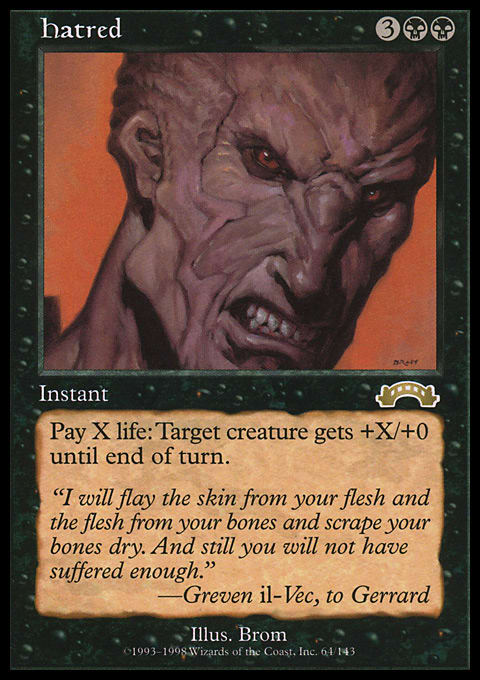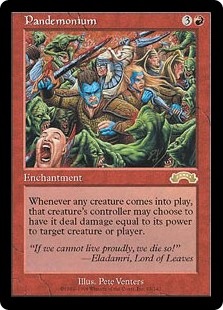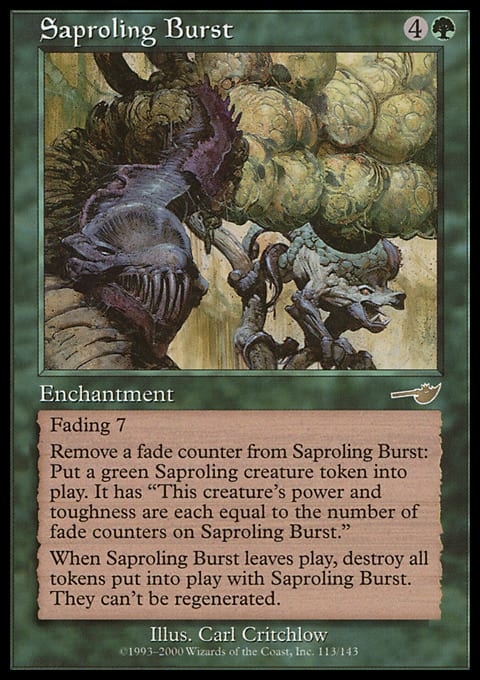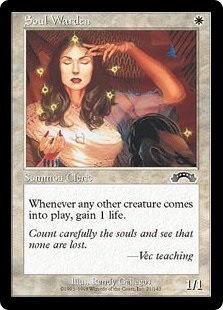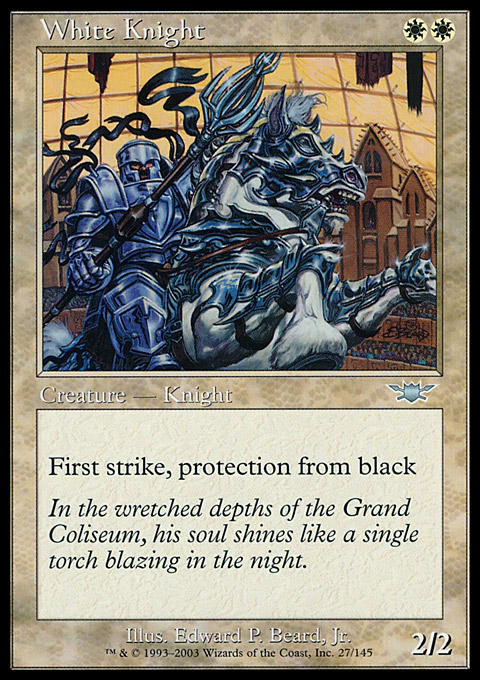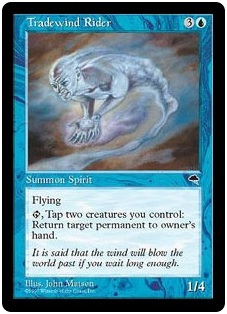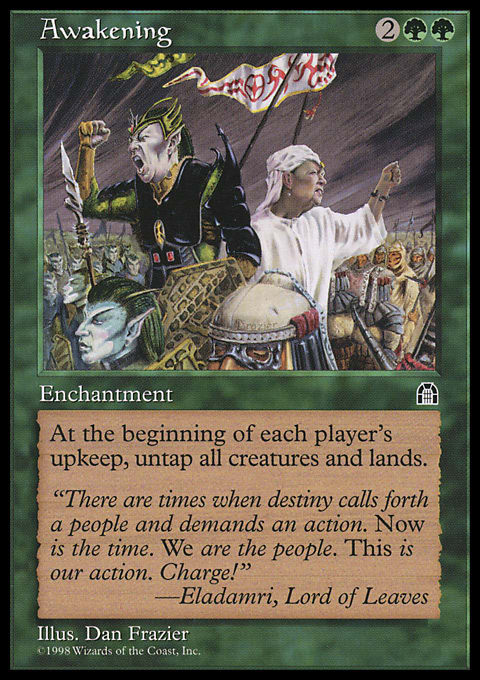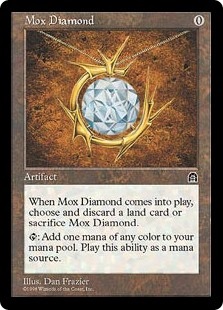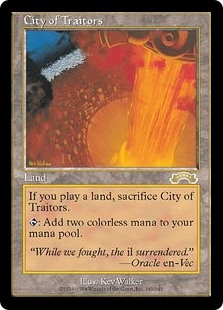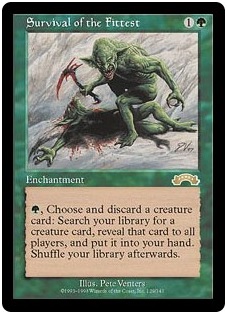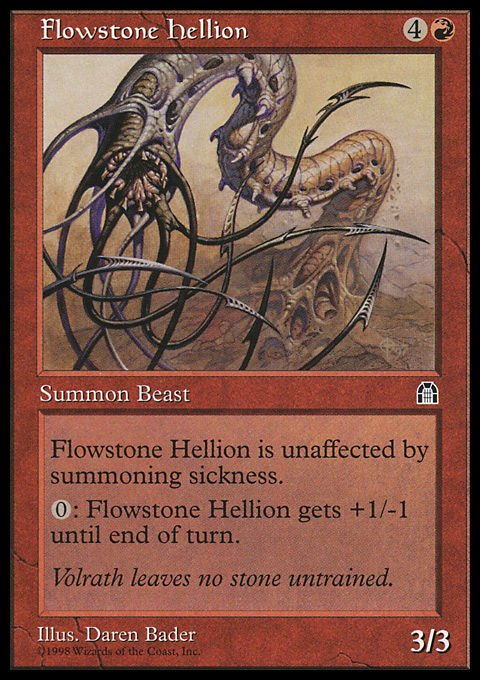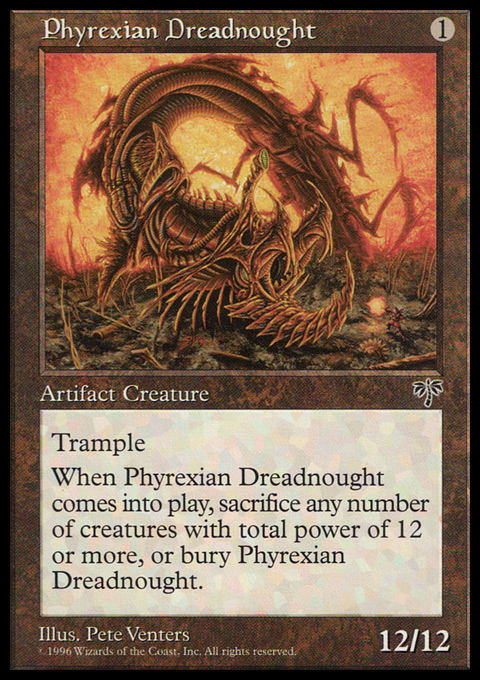Hello! Welcome back to the 2ndof my (hopefully) growing Top Ten Cards from Each Block. We started last week with the Top Ten Mirage Block Cards of All Time.
There's a bit of a nomenclature issue with the next block.
At the time, the three sets of Tempest, Stronghold, Exodus were known as the Rath Block, named after the plane of Rath where it took place. I still use that name to this day. However, the traditional naming scheme of naming it, "FIRST SET Block" means that a lot of people think of it as Tempest Block. I am using Rath Block here, because that was its name at the time, and I want to be true to its context. Plus, it's a cooler name.
The problem with putting together this list is that there are just too many cards that dominated their format.
For example, take multiplayer. Anthony Alongi rated Grave Pact as the best card ever printed for multiplayer. I consider Volrath's Stronghold to be. Both were printed in this block.
You also have more than ten engines that have fueled a lot of decks.
Here's a good example:
This is Hatred. Now, Hatred came out at the same time as a few powerful 1-drops like Sarcomancy and Carnophage, as well as fast-mana with the reprinted-and-still-legal Dark Ritual or the new Culling the Weak. The goal of this powerful Suicide Black deck was to force out a fast Hatred Kill on the 3rd turn with Hatred, a powerful dork hitting, and fast mana. It could get a turn two kill with a Carnophage or Sarcomancy Zombie and then two Ritual effects.
Now Suicide Black was nasty powerful here, but Hatred wasn't the most powerful engine during this era, by far.
How about Pandemonium? It led to a Standard quick-kill with various effects, and was a powerhouse in Standard with Saproling Burst, as they combined to deal 21 damage in a deck called "21." I'm sure you can figure out why. Is Pandemonium making my list? Of course not.
Furnace of Rath? Time Warp? Nah.
Even if this list were called, "Top Ten Combo Engines from Rath Block," then it still wouldn't have enough space for key stuff out there.
And we need space for non-combo stuff as well. Other cards that aren't combo pieces but are key cards from the Block need to be here too.
So, let's kick this thang off, and then you can yell at me later for whatever I missed.
Honorable Mention - Capsize, Common
Coming in at essentially #11 on my list is the best (single-target) bounce spell ever printed. It will target anything, and it will bounce it back. The buyback is reasonable for when you need to keep bouncing, and it plays great at the end of someone's turn. Because it can be used to bounce back a land, it can keep folks from ever getting more lands in play than they have right now, barring an effect like Exploration or Explore that allows multiple lands to be dropped. This spell can be used to bounce something back that came under your counter shell and then countered. It's the ultimate weapon and answer for Blue. And this is particularly true in an era of #3 below!
10 - Soul Warden, Common
No card from this era was as ubiquitous as Soul Warden, save for the colorless #4 below. This was particularly true at the kitchen table where every White deck ran four of these. Soul Wardens were insidious at slowly ticking up a life total without anyone really noticing. There have been entire articles written about Soul Warden (Including myself). And it wasn't just kitchen table dominance either! It made the cut in various decks at the tournament tables as well and was played in several matchups, such as Standard and Extended. It's legal in Modern and has made appearances in decks like Soul Sisters. It led to many cheap, on-curve White creatures that gave you some life gain, and where very attractive in tournaments as a result.
Imagine, as an example, that there were two sets of White Knights available for a given build:
Your normal White Knight, and then a variant we'll call "Life Knight" that doesn't have protection, but instead gives you three life when it arrives to the battlefield. Now if we are playing rival White Weenie decks, and you run White Knight, and I choose Life Knight, then I am going to gain 3 or 6 life while still playing on-curve 2/2 first strikers. That's how you win games in these aggro- matchups, by making your foe jump through bigger hoops to kill you than you need to kill your enemy. Soul Warden inspired that, and she can dominate an aggro on aggro matchup as a first turn drop that can get you 8 or 10 life over the course of the game as each side plays stuff. Soul Warden is amazing!
9. Living Death, Rare
Living Death has never been equaled before or since. It is a unique and powerful card that defines casual and tournament Magic. It will take out the entire board in one go, and force everything in play to be sacrificed. It also, at the same time, brings back everything that was in graveyards for another go around the battlefield. There are many ways to abuse this, but it's one of the best examples of what I call my WALD theory that puts game-changing cards into three categories:
Wrath of God - These are massive cards that you cast when you are behind, and then they bring you back to a neutral state, just like Wrath of God does when you are losing the creature battle.
Armageddon - These are massive cards that you cast when you are a little ahead and then they push you into further dominance. You cast Armageddon when you have some creatures and your foes don't, and then make it much harder for your foes to recover.
Living Death - This spell can be used to take you from losing to winning in one sweeping moment. You can be behind on creatures, and then when you cast this your foe has their one dead creature back to your four or five dead dorks back, and now you win. It's a big game swing.
That's what Living Death does. It pushes a table. It also made a significant impact on tournament games during its run in Standard and other formats. Living Death for the win; literally!
8. Tradewind Rider, Rare
The most onerous card from this era, especially in Standard, were not the cards above or below. Instead they were this powerhouse and the many shells it appeared in. The ability to merely tap a couple of dorks and itself to bounce something without spending any mana at all was incredibly powerful and versatile. As a result, it made the cut in many, many shells. Anything that played Blue and creatures played this.
For example, one combo shell was built around Awakening in a deck called Trade-Awake. You included powerful Green slow-down cards like Wall of Blossoms, Spike Feeder, and Spike Weaver with this shell and you could easily bounce four permanents each round with the untapping, and then when you added in Capsize from above? It's a nasty tempo lock that's hard to do anything with, in a deck with 8 counters to stop you from doing so.
7. Propaganda, Uncommon
Other than the poorly received Koskun Falls from Homelands, Propaganda was very much the first one of these effects to catch on. It was a big deal and led to many versions later like Ghostly Prison and Windborn Muse. You must pay a toll if you dare to attack me! It made the cut in a number of anti-creature builds that needed time to set up shop. You would see in in control and combo decks all over Rath Block Constructed, Standard, and Extended. It also was a major hit at kitchen table play and left a giant imprint in formats like Commander, where it's still a powerhouse today. This is a card that would have made your Top Ten then, and today as well. It will forever be a tool to lean heavily on.
6. Oath of Druids, Rare
Oath of Druids was a key factor in the game, both then, and now, and has made an appearance in multiple formats, such as Legacy and even Vintage. If it's been legal in that format, then it's had decks in it. One of the key answers against it was to play creature light deck, or to wait to play them for maximum effect. It will run Verdant Touch or Forbidden Orchard to give your foe a dork, and then thus, activate Oath for that Akroma, Angel of Wrath/Darksteel Colossus/Blightsteel Colosusus/Sliver Queen/Verdant Force/Spirit of the Night/Emrakul, the Aeons Torn or whatever else happens to tickle your fancy. It's going to win quickly, and that's what matters. It dominates the table, and it loves cards that either want a nice filled graveyard (such as threshold) or that can restock your deck to keep you from decking yourself (such as Gaea's Blessing).
Oath of Druids for the win!!!
5. Sliver Queen, Rare
As the first five color legendary creature as well as the first five-color card, Sliver Queen was unique. She led a tribe that remains popular at the kitchen table today. She was played in a lot of shells during her run. Because she was Green, she'd often be fetched out by Natural Order decks. She'd make the cut in a RecSur deck or a Full English Breakfast deck (see below for details on those). She was a unique card that made a powerful imprint on the game that can still be felt today. Sliver Queen baby!
4. Cursed Scroll, Rare
No card from this era was as commonly played as Cursed Scroll. It dominated this era. It pushed Red to the top of the heap with cards like Fireblast, Mogg Fanatic, Jackal Pup, and Lightning Bolt all legal at the same time. It enabled fast decks that dropped their hand quickly, like Green's Stompy. It gave burn to colors that needed it and was the final 4 or 6 damage used to finish someone after your initial onslaught was stopped. In fact, Cursed Scroll was banned for Rath Block Constructed. It's the only card that was so pervasive and onerous that it's been ban-hammered in for that Block's Constructed! Think about that in the context of the many powerhouses of this Block. Don't sleep on Cursed Scroll.
3. Fast Mana - Dream Halls, Culling the Weak, Mox Diamond; Lotus Petal; Ancient Tomb; City of Traitors (3 Rares, 1 Uncommon, 2 Commons)
One of the biggest things that this block does is run out a lot of fast mana options. These enable many of the combo pieces and engines that broke forth. These enable many of the other powerful decks as well. Suicide Black isn't a Standard legal combo kill around Hatred without it, and many others follow similar paths. Many of these cards are among the most commonly played in Commander, Vintage, Legacy, Standard, and Extended during their run. The ones that aren't on the Reserve List were never reprinted in a later set and thus brought into Modern. These cards tend to be pricey and for good reason!
Dream Halls, in particular, has broken countless builds with its free cost, and is a Legacy "Build-Around" All-Star. But everything from City of Traitors to Mox Diamond is just powerful here.
2. Recurring Nightmare, Rare
This little thing is so powerful that it's banned in a lot of places. The major issue with the Nightmare is it's templating that after it has been resolved, there is no window for my foes to destroy it until I pass priority. The self-bounce is part of the cost, so I never grant you priority until I activate it, and then, you can't destroy it as it's back in my hand. That leaves two answers to the Nightmare - counter magic and discarding. Only Blue and Black can answer it, even though it's enchantment nature should make it eligible for destruction by colors that destroy enchantments. That's in addition to the power it rocks with the three mana and sacrificing of one creature for another's return to the battlefield. And it's recursive, and thus powerful. It really loves cards like #1 below, Buried Alive from last week's list or creatures that have death-triggers and want to die for the greater cause. (Or something cheaper that already did its thing on arrival, and now is looking to die so you can return something bigger.). It's nasty at any stage of the game.
1. Survival of the Fittest, Rare
Recurring Nightmare might get the banhammer in a lot of places, (*cough*Commander*cough*) but Survival is the strongest card from the block. It's solely responsible for causing a plethora of problems and complications with things. It encourages a one-of deck-build with creatures that creatures a strong Swiss Army knife approach, and tons of folks loved that. Including myself. It directly led to the onerous RecSur deck that was arguably one of the strongest Standard decks of all time.
But it wasn't just the junior partner in crime from #2 above...
One of the things that has made this so powerful is that the discard is part of the payment, not part of the effect. Now you might normally think of that as a disadvantage, and you'd usually be right!
But it does give you a way to monkey around with cards that care about your graveyard without your opponent having a say in the matter.
For example, take the nasty combo Full English Breakfast
Sample Full English Breakfast Decklist | Abe Sargent
- Creatures (26)
- 1 Bottle Gnomes
- 1 Crystalline Sliver
- 1 Flowstone Hellion
- 1 Gilded Drake
- 1 Uktabi Orangutan
- 2 Elvish Lyrist
- 2 Phyrexian Dreadnought
- 2 Quirion Ranger
- 3 Tradewind Rider
- 4 Birds of Paradise
- 4 Volrath's Shapeshifter
- 4 Wall of Roots
- Instants (8)
- 2 Dissipate
- 2 Forbid
- 4 Counterspell
- Enchantments (4)
- 4 Survival of the Fittest
- Lands (24)
- 6 Forest
- 6 Island
- 4 City of Brass
- 4 Reflecting Pool
- 4 Undiscovered Paradise
This deck uses Survival of the Fittest to win quickly in a nasty way. How? Drop Survival. Then find or cast the Shapeshifter. It's a copy of the top creature card in your graveyard. Now discard Flowstone Hellion which gives it haste, a 3/3 and the ability to flow and give it +1/-1. Attack. Put 11 triggers on the stack. Discard the Dreadnaught. Kill with a 23/1 trampling machine of death. Because you put the dork in your graveyard, you can respond without leaving your foe an option to respond back.
The Survival was so powerful that it didn't need Recurring Nightmare to be broken, and there were many decks that broke people's faces during this time that Survival created.
And there we are!
Cards that were ion my short list included Aluren, Goblin Bombardment, Ensnaring Bridge, Intuition, Diabolic Edict, Spike Weaver, Wasteland, and Verdant Force.
Thanks for reading! Where did I go wrong? What did I miss?
Appendix of Top Ten Block Lists:
Did you enjoy throwback list of the best cards of yore? Did you want to keep going back and check out some more fun times? Excellent! Check these out as well!














